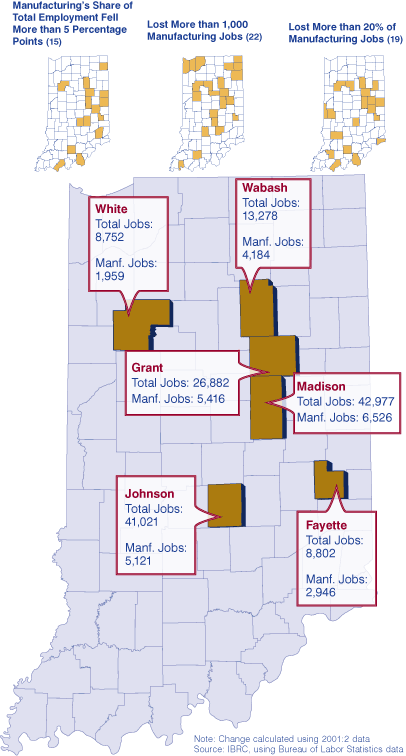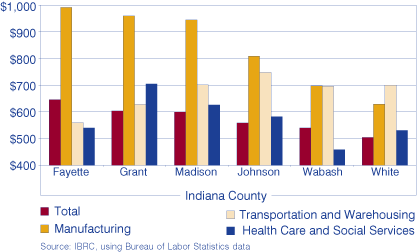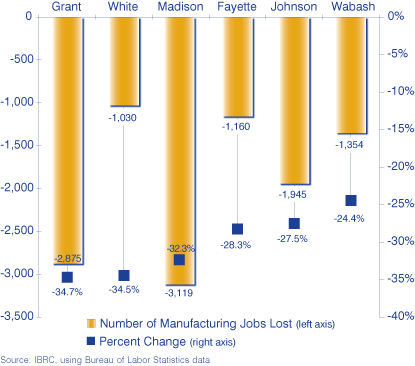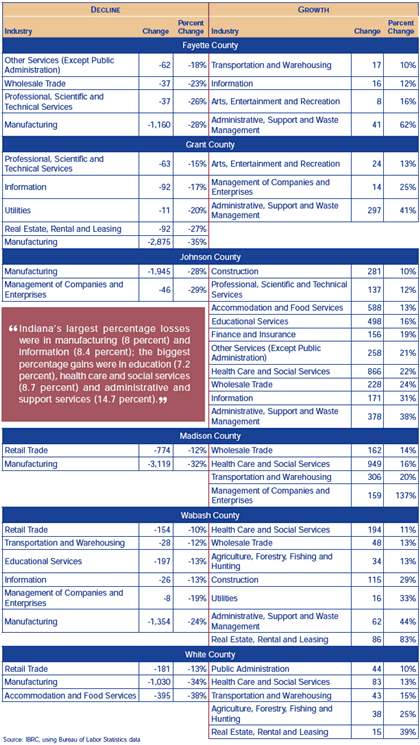Manufacturing Counties—The Fallen
Last month, we looked at Indiana's 11 manufacturing powerhouses—those counties where “making stuff” constitutes more than 40 percent of their total employment. This month, we look at those counties whose manufacturing sectors have been hardest hit since the recession.
In 15 counties, manufacturing as a share of total employment dropped more than 5 percentage points between the second quarters of 2001 and 2005. Twenty-two counties lost more than 1,000 manufacturing jobs; meanwhile, 19 counties lost more than 20 percent of their manufacturing jobs. Six counties (Fayette, Grant, Johnson, Madison, Wabash and White) had the dismal distinction of being included in all three categories and will be the focus of this article (see Figure 1).
Figure 1: The Fallen Manufacturing Counties, 2005:2

Geographically, they are fairly dispersed, though none are in the southern part of the state. Two of these counties are in Economic Growth Region (EGR) 3, two are in EGR 5, with one each in EGRs 4 and 6. Johnson County is part of the Indianapolis metropolitan area, while Madison County comprises the Anderson metro. Wabash, Grant and Fayette counties are each considered micropolitan statistical areas (the Wabash, Marion, and Connersville micros, respectively).
Manufacturing Jobs Since 2001
Combined, the six counties had roughly 26,200 manufacturing jobs in the second quarter of 2005, down from over 37,600 jobs four years earlier—a drop of 31 percent. The number of manufacturing jobs in each county ranges from 1,959 in White County to 6,526 in Madison County.
Manufacturing's share of total employment ranges from 12.5 percent in Johnson County to 33.5 percent in Fayette County. All but two counties (Johnson and Madison) rely more heavily on manufacturing employment than Indiana as a whole. Grant and White counties have a little over 20 percent of all jobs in manufacturing, while Wabash and Fayette counties still top 30 percent.
In the four years since the second quarter of 2001, Grant, White and Madison counties lost over 30 percent of their manufacturing employment (see Figure 2). Grant and Madison also had the largest losses numerically, with respective declines of 2,875 and 3,119.
Figure 2: Change in Manufacturing Jobs, 2001:2 to 2005:2
A Common Thread
Part of the problem in Grant and Madison counties can be traced to the crisis engulfing America's auto companies and their dependence on that industry. Indeed, this impacts five of the six counties, where companies somewhere in the automotive supply chain are among the largest employers (see Table 1).
Table 1: Manufacturing Companies in the Automotive Supply Chain who are Among the County's Largest Employers
Consider that both Grant and Madison County—the hardest of the hardest-hit in terms of manufacturing losses—are particularly reliant on the health of General Motors.
The city of Marion, in Grant County, is home to a GM stamping plant that employs about 1,700. Then there's Amcast Automotive in Gas City, a company supplying GM with aluminum wheels—at least until this spring. GM announced plans to ultimately find another supplier as part of its cost-cutting measures. Amcast filed for bankruptcy in December, just four months after emerging from its first one. The company's future also impacts Johnson County because of the Casting Technology Co. plant in Franklin, an Amcast subsidiary.
Meanwhile, Madison County is still dominated by GM spin-off companies, despite tremendous cutbacks over the past decade. Guide Corp. remains the county's largest employer with 2,100 workers, according to the Anderson Chamber of Commerce. The now-bankrupt Delphi ranks sixth. In 2003, Remy International closed its manufacturing facility in the city, but kept its headquarters there, which leaves it in the top 15 employers. In all, these three former GM companies, plus the ELSA Corp. (which produces exhaust systems and fuel tanks for Mitsubishi and Subaru), employ around 3,900 workers.
The data for the transportation equipment manufacturing subsector is only disclosable for four of the six counties. Of those, Wabash County had a net gain of 29 jobs between 2001:2 and 2005:2. Madison County had the largest decrease, both numerically and on a percentage basis (-2,274 or -39 percent). Johnson County dropped 31 percent (-654 jobs) while Grant County fell 15 percent (-409 jobs).
Is It All That Bad?
A recent article in The Economist takes the perspective that the disappearance of manufacturing jobs is a sign of economic health in developed economies for two reasons:
Households only need so much “stuff,” so as incomes go up, a larger share is spent on services, such as vacations and education.
Automating manufacturing requires fewer workers, but raises productivity. This allows workers to move into other industries, boosting output and living standards as a result.
Unfortunately, in five of these six counties (Johnson County is the exception), total employment decreased more than 6 percent, meaning that other industries aren't picking up the slack. The drop in total employment ranged from -1,127 in Wabash County to ‑2,979 in Madison County (see Figure 3).
Figure 3: Change in Total Employment, 2001:2 to 2005:2

Of course, layoffs and shutdowns don't just affect the manufacturer itself, but ripple through the economy, negatively impacting the restaurant across from the plant, local retailers, etc. This can be seen particularly in Fayette, Grant and White counties, where manufacturing losses were lower than total job losses.
Table 2 shows the biggest gainers and losers at the industry level for each county. For comparison, Indiana's largest percentage losses were in manufacturing (8 percent) and information (8.4 percent); the biggest percentage gains were in education (7.2 percent), health care and social services (8.7 percent) and administrative and support services (14.7 percent). Health care and administrative and support services showed strong growth in most of the six counties; education employment, however, declined in four of the five counties (data were nondisclosable for Fayette County).
Table 2: Industries with a Decline or Gain of 10 percent or More
Population
As a group, the counties have nearly 412,000 residents. With fewer jobs, are residents leaving or just commuting farther? Census Bureau population estimates show that, with the exception of Johnson County, each of these counties lost population between 2000 and 2004. Whereas the state grew 2.4 percent, Fayette, Grant and Wabash declined by roughly that same amount. White and Madison declined slightly less, at -1.6 percent and -2 percent, respectively.
Meanwhile, Johnson County benefits from the suburbanization surrounding Indianapolis. Its population grew by 9,869 people (8.5 percent), making it the third fastest growing county in the state numerically and fifth fastest on a percentage basis. Three of its cities—Greenwood, Bargersville and Trafalgar—were among the 20 fastest growing cities in the state. Interestingly, while Madison County also benefits from a close geographic proximity to the Indianapolis metro (and was actually part of the metro prior to the 2003 redefinition), it has not seen the growth experienced by the other ‘donut' counties.
Wages
The Economist also makes the claim that societies cling to manufacturing jobs out of a misplaced belief that manufacturing is “better:”
“There is a residual belief that making things you can drop on your toe is superior to working in accounting or hairdressing. Manufacturing jobs, it is often said, are better than the Mcjobs typical in the service sector. Yet working conditions in services are often pleasanter and safer than on an assembly line, and average wages in the fastest-growing sectors, such as finance, professional and business services, education and health, are higher than in manufacturing.”
How does that play out for these six counties? The total average weekly wage for the second quarter of 2005 ranged from just over $500 in White County to almost $650 in Fayette County. Figure 4 looks at total and manufacturing wages in relationship to two of the fastest growing (numerically) service sectors: transportation and warehousing and health care and social services. In White County, transportation and warehousing wages actually surpass those of manufacturing by $71, while there's just a $1 difference between the two in Wabash County.
Figure 4: Average Weekly Wage Comparison, 2005:2

However, things are drastically different in Madison, Grant, and Fayette counties, where the average manufacturing wage is ranked in the top 12 in the state, and exceeds that of transportation and warehousing by $240 to $430. Numbers like that make it hard to dismiss the fact that high-paying manufacturing jobs are being replaced with ones that pay considerably less.
Nevertheless, the overall average weekly wage increased between 2001:2 and 2005:2 for all six counties, ranging from a $12 increase in Fayette County to a $67 increase in Johnson County.
At the industry level, five of the six counties had at least two industries with declining wages. (Johnson County is once again the exception because all of its industries posted gains.) Industries where at least two counties had a declining wage include administrative and support services; arts and entertainment; construction; management of companies; and real estate, rental and leasing. Meanwhile, manufacturing wages were stable in Madison County, but increased by at least $45 among the other five counties; both Grant and Johnson counties saw gains exceeding $100.
Notes
- Arundhati Parmar, “Amcast Latest Auto Calamity,” Fort Wayne Journal Gazette, December 18, 2005.
- “Industrial Metamorphosis,” The Economist, October 1, 2005.
- “The Great Jobs Switch,” The Economist, October 1, 2005.
Rachel Justis, Managing Editor
Indiana Business Research Center,
Kelley School of Business, Indiana University



